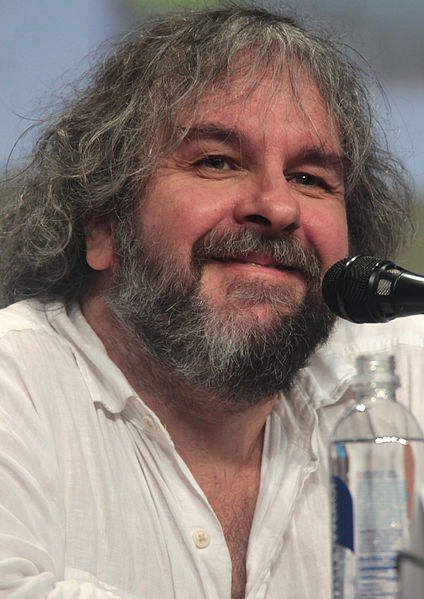
Lord of the Rings director Peter Jackson at the 2014 San Diego Comic Con International. (Photo by Gage Skidmore, CC, https://www.flickr.com/photos/gageskidmore/14602576517/)
On the occasion of his sixtieth birthday, I make this heretical pronouncement: Peter Jackson’s cinematic Lord of the Rings trilogy is better than J.R.R. Tolkien’s literary one. And I say so without embarrassment, no matter how many cultural pedants deem it unthinkable for a literature professor to suggest that the movies are better than the books.
Perhaps, even twenty years after Jackson’s The Fellowship of the Ring first premiered in multiplexes around the world, my opinion remains objectionable. Yet I cling to it, remembering how frequently I thought so during my inaugural viewings of all three LOTR adaptations, wedged as I was (each time!) into opening-night crowds packed with people wearing Tolkien regalia from the small (lapel pins proclaiming “Frodo Lives!”) to the large (T-shirts emblazoned with a giant golden ring circling the inscription “Here’s Your Bling”) to the kooky (namely, a fellow who patterned his full Gandalf costume after the wizard’s appearance in Ralph Bakshi’s 1978 animated LOTR movie).
Jackson, of course, did not improve his films’ literary sources alone. Co-writers Philippa Boyens and Fran Walsh smartly pruned Tolkien’s unruly novels down to long-but-gripping screenplays. The talented cast, led by Sir Ian McKellen as Gandalf (who accepted the role only after Sir Sean Connery, claiming he could not understand Fellowship’s script, passed), brought the story to magnificent life. The tireless production crew expertly realized Jackson’s fevered commitment to transferring Tolkien’s Middle Earth, in all its scope and splendor, to the screen. Plus, Howard Shore’s musical score nimbly fused stentorian seriousness with the emotional delicacy that Tolkien’s writing, in its best passages, made so resonant.
Yet it was Jackson riding herd over this mammoth production, the likes of which audiences had not seen since the heydays of Cecil B. DeMille, David Lean, and Akira Kurosawa. Three movies adapted from a beloved literary series shooting hundreds of sets and locations for fifteen months, almost without pause, in an attempt to put New Zealand on the global cinematic map? Who was crazy enough to think such a project could ever be finished, much less succeed? What madman would shoulder the burdens of this impossible task? What nutcase would risk the wrath of the Tolkien cult, as stridently vocal a fan community as the twentieth century ever produced?
Well, we all know the answer to these questions, making me only one in a long line of Jackson’s admirers. His fortitude in tackling the Lord of the Rings adaptations at all is praiseworthy in light of how terrible the results might have been.
Even so, proclaiming Jackson’s film trilogy superior to Tolkien’s literary source does not make Peter’s work unassailable. Make no mistake, I was happy to see Tolkien’s excesses excised from the movie trilogy’s narrative, chief among them: 1) the witless Tom Bombadil-and-Goldberry interlude, 2) the hobbits standing dumbstruck before the majesty of endless, never-before-encountered landscapes (in prose ornate enough to make even Ann Radcliffe blush), and 3) the elves ceaselessly singing—singing here, singing there, singing at the drop of any hat or head covering, singing for no reason at all, singing so much and so often we may be forgiven for thinking they come straight out of the Gilbert-and-Sullivan musicals of the British stage rather than the mythic traditions that Tolkien ransacked again and again.
Even so, with the singular exception of Christopher Lee’s magisterial Saruman the White, Jackson makes nearly all his LOTR evildoers darker of skin than the trilogy’s goody-goody heroes, a mistake he repeats in his otherwise commendable 2005 remake of King Kong (where Skull Island’s indigenous inhabitants appear as primitive islanders rather than civilized residents). And Jackson’s decision to expand The Hobbit—as lean and lithe a narrative as Tolkien ever composed—into a bloated cinematic trilogy (after releasing progressively longer versions of each LOTR film on DVD) proves again how even a great artist can go astray when his much-balleyhooed “vision” (to say nothing of his quest for continued relevance and box-office profits) overwhelms good sense.
So, my esteem for Peter Jackson has limits even if, in my judgment, he remains a remarkable poet-director. Commemorating his birthday calls forth warm feelings and happy memories, but, to understand his artistic strengths, we must also acknowledge his weaknesses.
Indeed, when considering Jackson’s cinematic career as writer-director, I find myself returning to those movies he made before the LOTR trilogy blazed its way across our collective cinemascape. These earlier films, from what some observers call Jackson’s “splatter phase,” include deliriously entertaining horrorfests with pulp-fiction titles like Braindead (North American audiences know it as Dead Alive). This outrageous zombie movie includes so much gore that viewers either get the joke or get out, especially its climax, where protagonist Lionel Cosgrove (Timothy Balme) wields a running lawnmower to massacre a zombie horde in a sequence that required three hundred liters of fake blood to capture on film.
Then there is 1989’s Meet the Feebles, an anti-Muppet movie whose puppet characters’ enthusiasm for debauchery, filth, and violence helps fashion an absurdly effective satire. Given this pedigree, would it surprise you to learn that Jackson’s first feature film, shot on weekends over a period of four years, is a 1987 schlocker titled Bad Taste?
No? Well, trust me when I say, watch them all when you can.
And, despite my gentle criticisms here, if Peter Jackson ever reads this missive, I trust that he will accept my wishes for his abundant good health.
